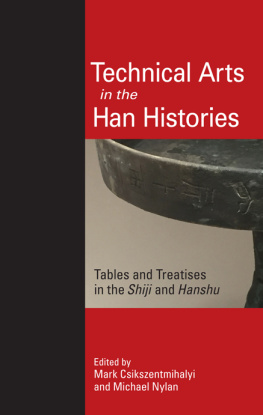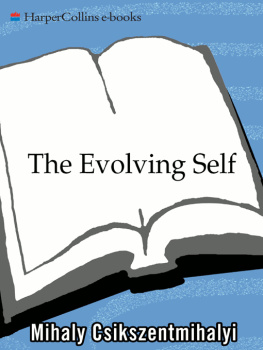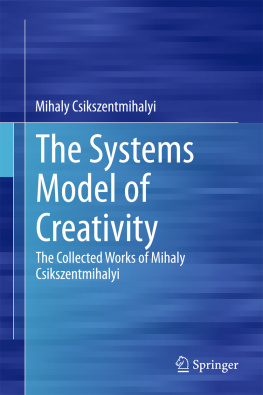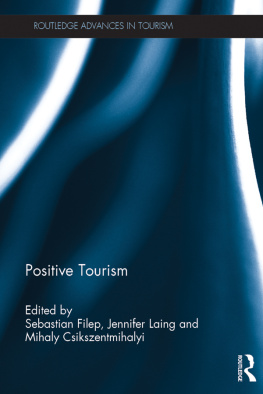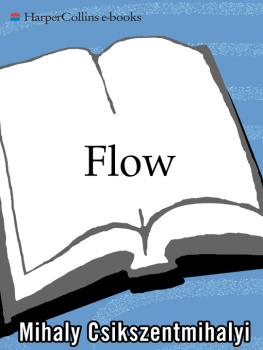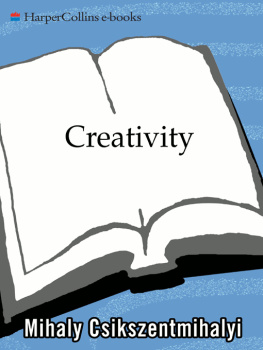Mark Csikszentmihalyi - Technical Arts in the Han Histories
Here you can read online Mark Csikszentmihalyi - Technical Arts in the Han Histories full text of the book (entire story) in english for free. Download pdf and epub, get meaning, cover and reviews about this ebook. year: 2021, publisher: SUNY Press, genre: Home and family. Description of the work, (preface) as well as reviews are available. Best literature library LitArk.com created for fans of good reading and offers a wide selection of genres:
Romance novel
Science fiction
Adventure
Detective
Science
History
Home and family
Prose
Art
Politics
Computer
Non-fiction
Religion
Business
Children
Humor
Choose a favorite category and find really read worthwhile books. Enjoy immersion in the world of imagination, feel the emotions of the characters or learn something new for yourself, make an fascinating discovery.
- Book:Technical Arts in the Han Histories
- Author:
- Publisher:SUNY Press
- Genre:
- Year:2021
- Rating:4 / 5
- Favourites:Add to favourites
- Your mark:
- 80
- 1
- 2
- 3
- 4
- 5
Technical Arts in the Han Histories: summary, description and annotation
We offer to read an annotation, description, summary or preface (depends on what the author of the book "Technical Arts in the Han Histories" wrote himself). If you haven't found the necessary information about the book — write in the comments, we will try to find it.
Technical Arts in the Han Histories — read online for free the complete book (whole text) full work
Below is the text of the book, divided by pages. System saving the place of the last page read, allows you to conveniently read the book "Technical Arts in the Han Histories" online for free, without having to search again every time where you left off. Put a bookmark, and you can go to the page where you finished reading at any time.
Font size:
Interval:
Bookmark:

Technical Arts
in the
Han Histories
SUNY series in Chinese Philosophy and Culture
Roger T. Ames, editor
Technical Arts
in the
Han Histories
Tables and Treatises
in the Shiji and Hanshu
Edited by
Mark Csikszentmihalyi
and Michael Nylan

Cover: Bronze oil lamp from the tomb of Liu He, the Marquis of Haihun, ca. 64 BCE. On the side is inscribed: Changyi Eunuch Imperial Messenger [regulation] ding-style lamp, weighing six jin ten liang, made in the second year. Photograph by Mark Csikszentmihalyi.
Published by State University of New York Press, Albany
2021 State University of New York
All rights reserved
Printed in the United States of America
No part of this book may be used or reproduced in any manner whatsoever without written permission. No part of this book may be stored in a retrieval system or transmitted in any form or by any means including electronic, electrostatic, magnetic tape, mechanical, photocopying, recording, or otherwise without the prior permission in writing of the publisher.
For information, contact State University of New York Press, Albany, NY
www.sunypress.edu
Library of Congress Cataloging-in-Publication Data
Names: Csikszentmihalyi, Mark, editor. | Nylan, Michael, editor.
Title: Technical arts in the Han histories : tables and treatises in the Shiji and Hanshu / Mark Csikszentmihalyi and Michael Nylan.
Description: Albany : State University of New York Press, [2021] | Series: SUNY series in Chinese Philosophy and Cultyure | Includes bibliographical references and index.
Identifiers: ISBN 9781438485430 (hardcover : alk. paper) | ISBN 9781438485447 (ebook)
Further information is available at the Library of Congress.
10 9 8 7 6 5 4 3 2 1
To Michael Loewe
by unanimous vote of the contributors,
with deep respect
Tamdiu discendum est quemadmodum vivas,
quamdiu vivas. Seneca, Letters
As long as you live, keep learning how to live.
Contents
Michael Nylanand Mark Csikszentmihalyi
Michael Loewe
Luke Habberstad
Lee Chi-hsiang
Jesse J. Chapman
Michael Nylan
Tian Tian
Karine Chemla
Miranda Brown
Mark Csikszentmihalyiand Zheng Yifan
Acknowledgments
In writing a book, especially an edited book, one always incurs many debts, and it is a pleasure to acknowledge them in due time. This book came into being to address some of the needs of our graduate students and best undergraduates to show them how scholars young and old tackle the technical issues, partly by doing and partly by watching other experts in the field discuss their own research projects. We editors were aware that the fields of Classics and the history of science were doing innovative work on the technical arts in antiquity, pushing the boundaries in ways that remained largely closed to those of us working in Early China studies, so we decided to take the plunge.
Of course, we must begin with the chief dedication of the volume, supported unanimously by the contributors, all of whom were canvassed through emails along with other routine inquiries, until it became clear that we had to stop emailing the probable object of the dedication himself. For each and every person save Michael Loewe put Michael at the top of the list of people we wanted to see honored for contributions to the field of Han history in general, and the technical arts in particular. As it would take far too long to list Michaels virtues as a scholar, colleague, teacher, and human being, suffice it to say that his Chinese name says it all: he is , the only one, that is, peerless.
All the contributors would like to thank Nathan Sivin, who commented on all the papers in various stages, sometimes more than once. Originally, the editors had planned to invite Professor Sivin to contribute his own chapter for the volume, which would describe where the history of the technical arts has been and is likely going in Chinese studies. Then, because of circumstances beyond everyones control (but common, alas, in academia), a few chapters did not appear on time for the volume, at which point it seemed unfair to ask Professor Sivin to plough through every chapter all over again and produce his own in short order. That said, a number of contributors consulted him via email about their chapters, and we have predictably benefited from those exchanges, we believe.
As a student, Csikszentmihalyis mentors in the technical arts were Sally Church, Robin Yates, Lothar von Falkenhausen, and Albert Dien. Since coming to Berkeley, he has been fortunate to learn from his students, Michael Nylan, and her students.
Nylans work on the technical arts began with study of the Taixuan jing under Nathan Sivin, proceeded with Paul Serruys and linguistics, and took an unexpected turn with early optics, with medicine and with manuscript culture, rooted always in history undergirded by archaeology. In matters archaeological, she has often benefitted from the superb guidance of Robert Bagley, her teacher, friend, and colleague, as well as from Michael Loewe.
A great many contributors commented on each others papers (as, for example, Luke Habberstad and Jesse Chapman read for Michael Nylan and each other). This has been an incredibly collegial bunch of people to work with: mostly on time with deadlines, endlessly patient in response to queries large and small, alert to the ways that they would like the papers to articulate with one another, despite the separate fields they largely represent. Besides this, we would like to thank the librarians at UC-Berkeley (Jianye He, Peter Zhou, Bruce Williams, and Deborah Rudolph especially) for their tireless work on behalf of faculty and students. Charles Aylmer, in the Cambridge University Library, hunted down materials for Michael Loewe.
At UC-Berkeley, the editors moreover had the help and support of the TaiwanUnited States Alliance (TUSA), which funded our initial meeting for potential contributors to plan such a volume late in 2014. We owe thanks to the Institute for East Asian Studies (then under Martin Backstroms leadership). Our respective departments (East Asian Languages and Cultures; History) gave the editors additional material and logistical support for the initial meeting with contributors. Finally, the Marjorie Meyer Eliaser Chair in International Studies provided support for the project at several key junctures.
Editors and contributors would like to thank Christopher Ahn for his encouragement early on with the project. We owe thanks to James Peltz and Roger T. Ames for their unfailing kindness and clear directions while shepherding the co-editors through the volumes final stages. We were fortunate enough to have the invaluable editorial assist from Vanessa Davies, an Egyptologist, whose steady intelligence, good cheer, and superb sense of the English language relieved the editors of considerable stress and gave us a good read on how best to convey some technical points to non-specialists. As Nylan was concurrently dealing with a less capable copy editor at another press, she was supremely mindful of what all academics owe to good editors at every stage of the complex process. The editors would also like to proffer warm thanks to Diane Ganeles at SUNY Press, and to Laura Tendler, for help during the final editing process.
Introduction
M ICHAEL N YLAN AND M ARK C SIKSZENTMIHALYI
Font size:
Interval:
Bookmark:
Similar books «Technical Arts in the Han Histories»
Look at similar books to Technical Arts in the Han Histories. We have selected literature similar in name and meaning in the hope of providing readers with more options to find new, interesting, not yet read works.
Discussion, reviews of the book Technical Arts in the Han Histories and just readers' own opinions. Leave your comments, write what you think about the work, its meaning or the main characters. Specify what exactly you liked and what you didn't like, and why you think so.

